Unito is a platform that takes a different approach to managing SaaS apps. Today we’ll take a look at how the company’s pitch deck helped it raise $20 million in Series B funding last year.
We’re looking for more unique pitch decks to tear down, so if you want to submit your own, here’s how you can do that.
Slides in this deck
Unito shared its 12-slide deck, which is lightly redacted: It removed some logos for the companies it works with and left out its target companies, revenue targets and its growth chart. Still, even with these details omitted, we get a great picture of the company’s narrative structure.
Here’s an overview of the slides:
- Cover slide
- Highlights/summary slide
- Market context slide
- Problem slide
- Solution slide
- Product slide
- How it works slide
- Product evolution slide
- Growth/traction slide
- Competition/positioning slide
- Team slide
- Summary slide
Three things to love
The slide deck is missing a lot of information that I’d have liked to see, but the information that’s there is extraordinarily clean and simple, without going too deep into the weeds. The slides’ design is simple, clean and easy to read. If you only take away one thing from this teardown, let it be: Simplify your slides!
Extraordinary team slide
At early-stage companies, “founder/market fit” is the name of the game. By the time you grow to a Series B, however, you’re on your path toward growth, and the focus of the senior team shifts toward building, growing and retaining your team. Unito’s team slide tells that story beautifully:
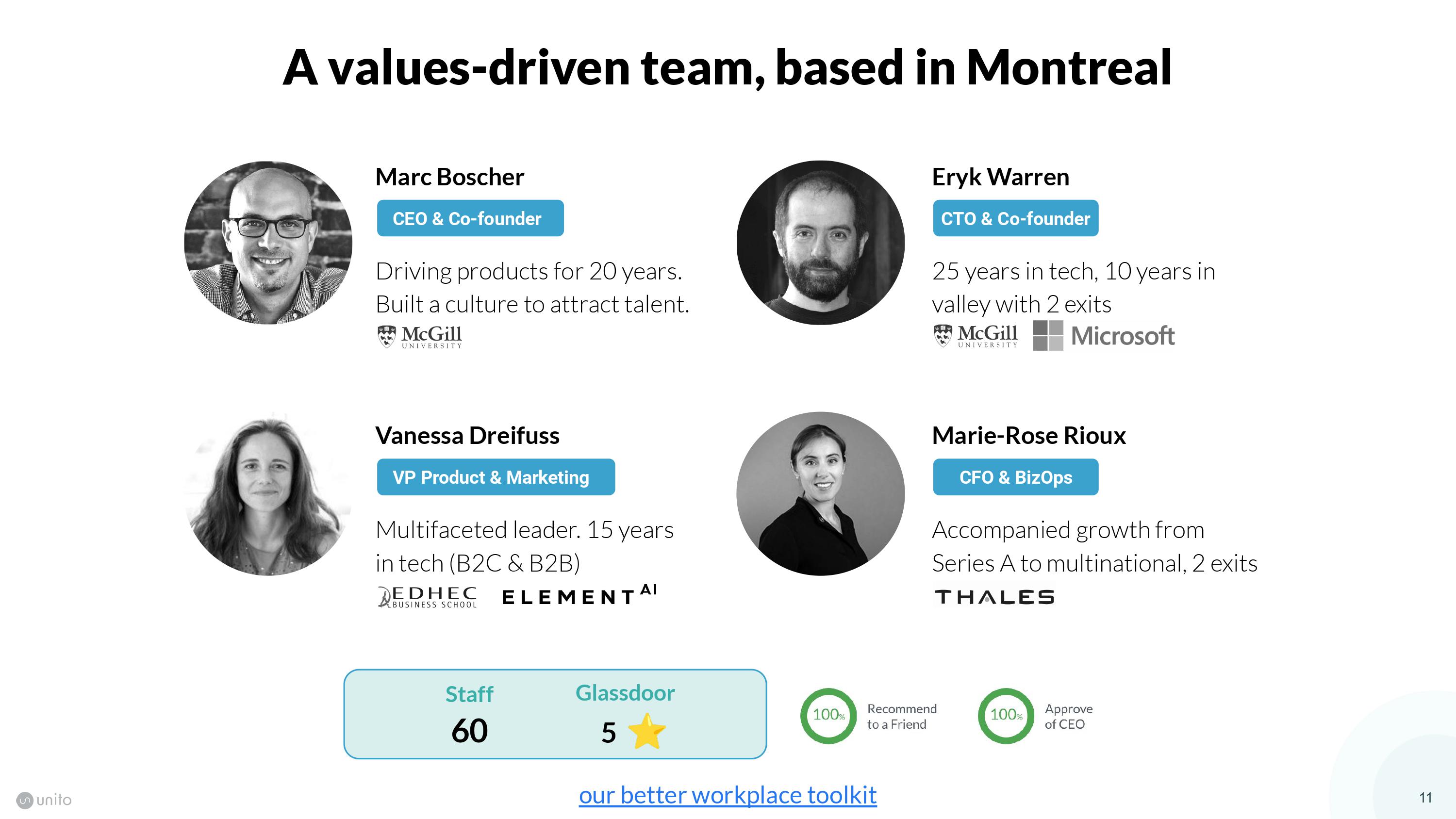
A combination of team building, startup experience and domain expertise lays the foundation for a great story around the senior team. The Glassdoor ratings and the company’s “better workplace toolkit” shows that it practices what it preaches, and that — combined with the company’s growth trajectory — goes a long way.
A logical evolution
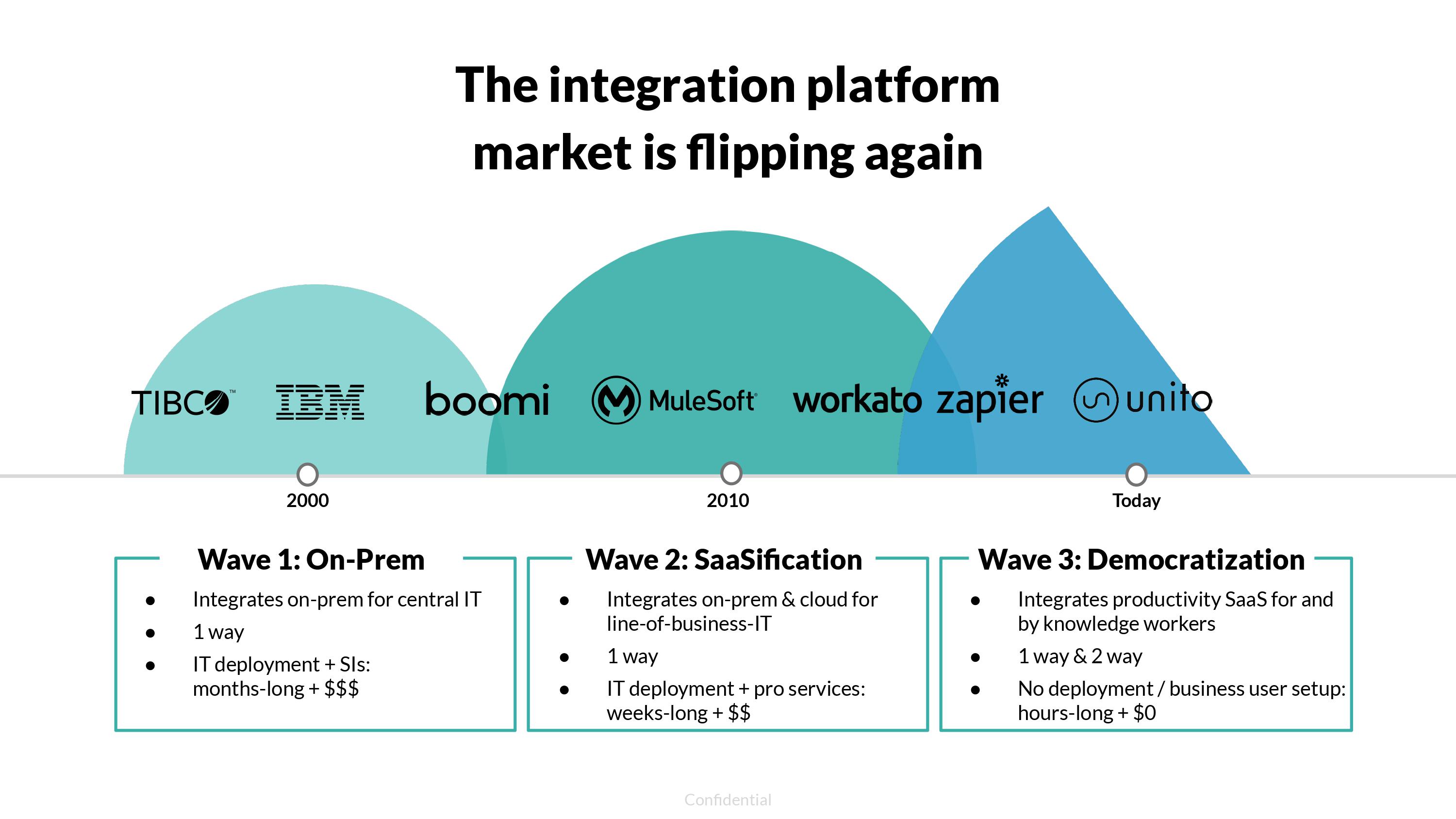
Humans are narrative-driven. Being able to tell the story of how a startup fits into the broader context is very smart. I have a particular weakness for market evolutions and seeing how verticals change over time. This is Unito’s third slide, and the company is using it to great effect, showing how it can be the obvious next evolution of how SaaS companies talk to each other.
It’s important to think about how your company fits into a historic context for your market or industry. This can be a great way to anchor a narrative to previous successful businesses and position yourself within the sector. In some cases, it can take the place of the “why now” part of your story.
Vertical expansion
Unito started by building a set of sync tools for a specific niche: keeping the tools that product managers use in sync with tools that developers use. That’s a great way to have a specific, well-defined set of tools you have to work with. From there, the company decided to start expanding:
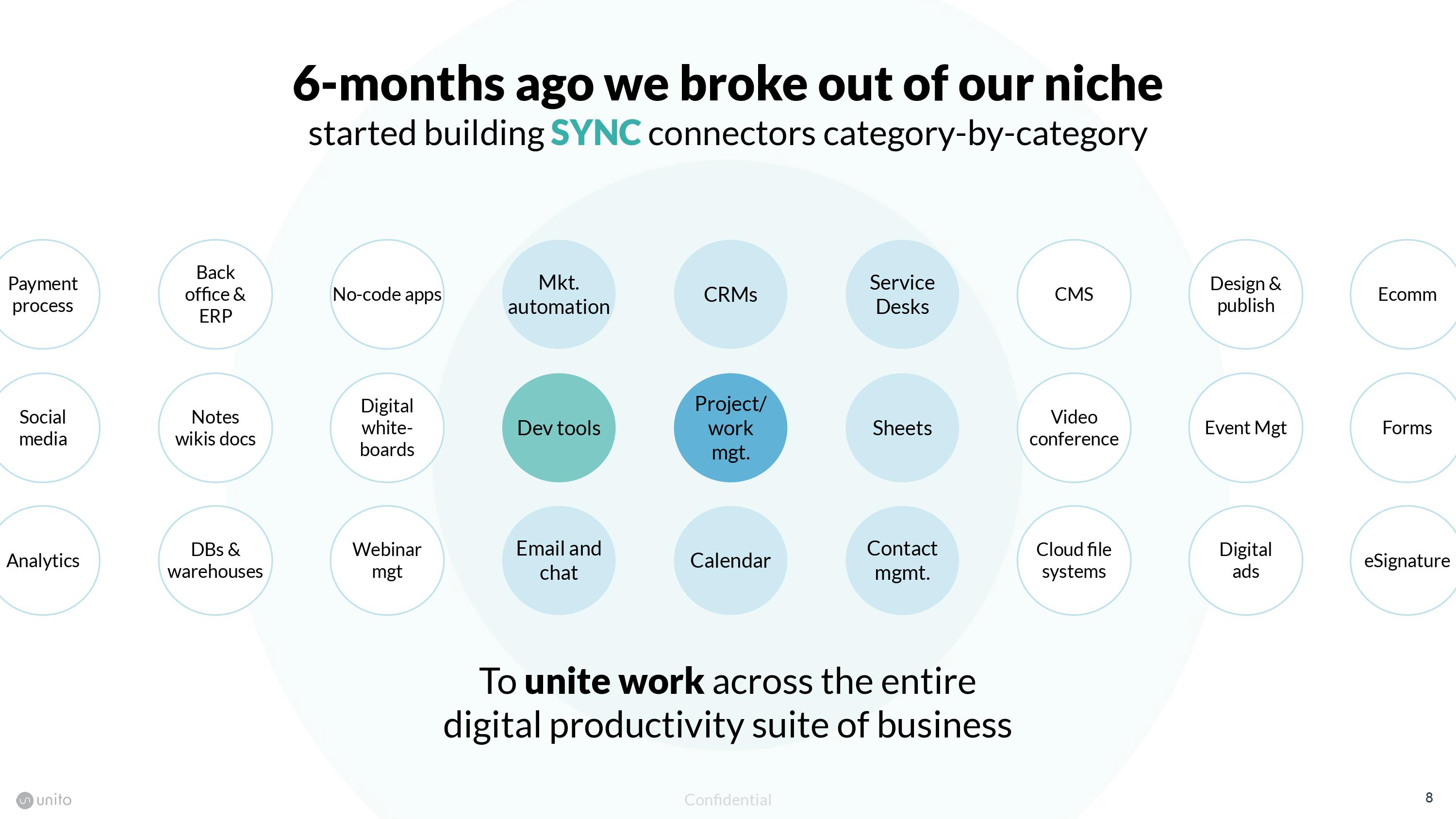
This type of expansion affects a lot of different things, not least the total addressable market. We usually see this type of expansion geographically: If you have a company that has built a set of solutions for Germany, you might expand to the rest of Europe or globally. Market expansions like this can be equally powerful. It means that the addressable market grows exponentially; adding marketing, contact management and social media to the sync matrix, for example, can open up huge new market opportunities and potential for growth.
It makes the same point, but more specifically, on its competition slide:
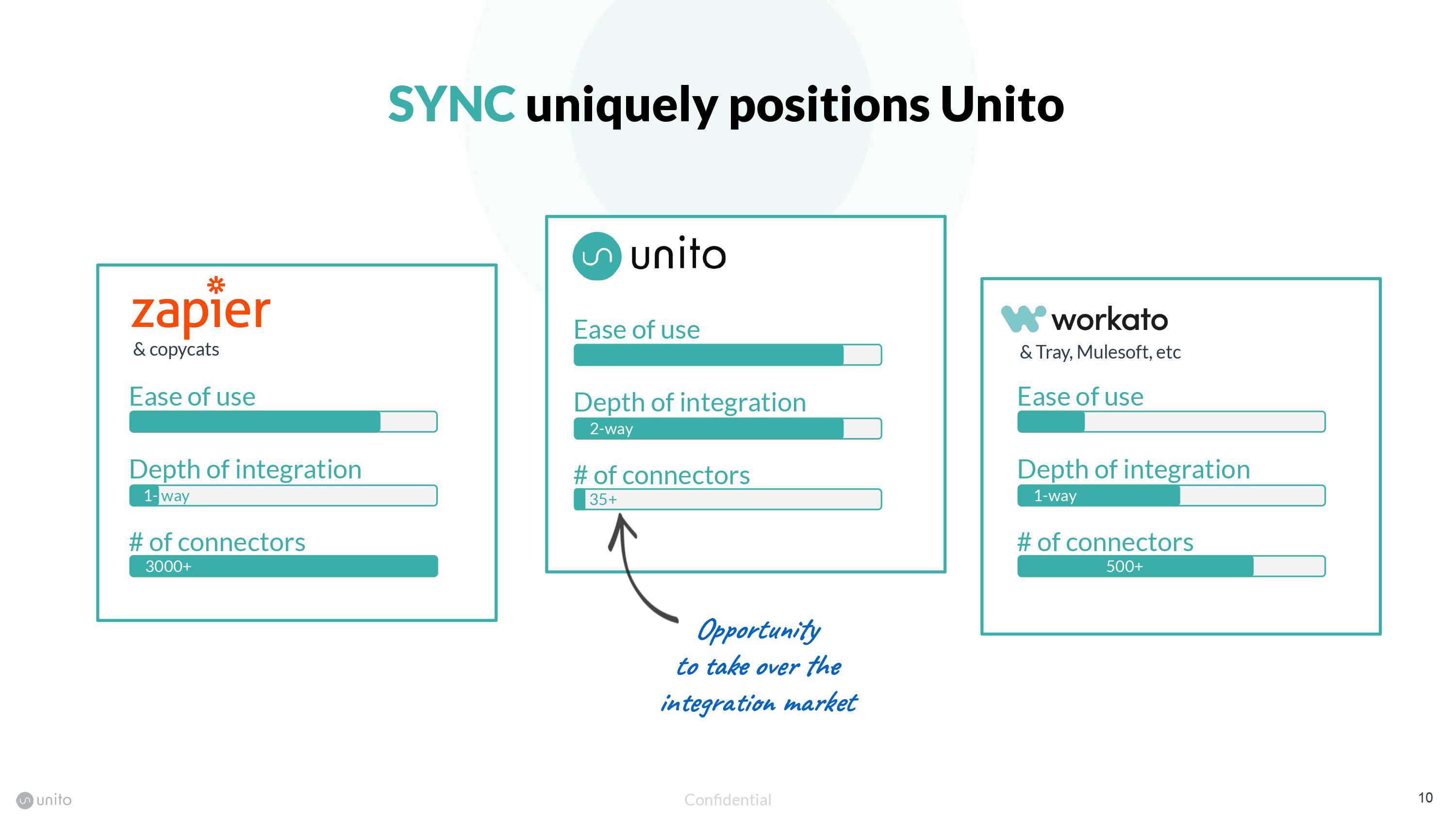
This is the type of thing you learn in business school, so it’s great to see it out in the wild. Strategically, the path Unito built makes a lot of sense, and I’m not surprised that this narrative resonated with investors.
In the rest of this teardown, we’ll take a look at three things Unito could have improved or done differently, along with its full pitch deck!
Three things that could be improved
There is a lot of information missing from this pitch deck that I’d have loved to see covered in some level of detail.
So, what are you going to do with the money?
This is a Series B deck, which means that the money raised is almost certainly going to be spent on growth. But questions — like the what, how, when and where — still remain. Companies need to have a detailed plan; for example, the money could be used to hire more staff, find new opportunities, develop more software, maybe acquire a smaller company or two. There are often a ton of ways to grow, so it’s crucial to give investors a glimpse into what you’re thinking.
If you’ve been reading this series for a while, you know what’s coming next: This pitch deck needs a good “ask” slide, and maybe an operating plan slide to tell the story of planned growth in numbers.
Underwhelming competition slide
I know I used the competition slide in the “good” section above, but there’s a downside to this slide, too. There are a lot of tools that are helping SaaS datasets stay in sync, and while Unito may have a good starting point, I’m really struggling to make sense of this slide:

For one thing, the graphs make very little sense. Sure, “ease of use” is subjective, so I’ll let Unito off the hook for that one. But if you look at the “number of connectors” graph, the visual representation is pretty confusing. In one, 3,000 is the full graph, in another, 35 is a sliver, and in the third, 500 is a lot more than you’d expect, compared to the two other graphs. That makes it hard to read and makes me a little dubious. The “depth of integration” slider is also confusing.
Zapier is a behemoth in this market, and writing it off without giving it any real analysis seems like a mistake. As an investor, I’d have a very simple question: What is stopping Zapier from launching two-way sync for a selection of its integrations?
This competition slide does a good job showing the size of the opportunity, but it doesn’t treat competitors with the seriousness they perhaps deserve. I suspect that will have made the due diligence process a fair bit harder than it needed to be for Unito in this round of fundraising.
SaaS companies deserve better traction
I know that Unito redacted some of its slides, but even so, it is missing a huge opportunity. SaaS companies have the advantage of being able to measure everything that happens on the platform. What a founding team chooses to measure — and the metrics it’s targeting — is an important part of the narrative for a would-be investor. This is an opportunity to show off that you know which levers are important in the business and which ones you can put on the back burner. Overall, Unito’s deck read like “Hey, we did a thing, and now we are going to do a bit more of the thing.” That makes sense; after all, if it ain’t broke, don’t fix it.
But as an investor, I’m disappointed. Growth-stage companies should have tons of data, and even just showing a screenshot of the dashboard that the company is using to steer its proverbial ship in the right direction would give meaningful information.
The only hard data in this slide deck (even with the axes redacted) is this slide:
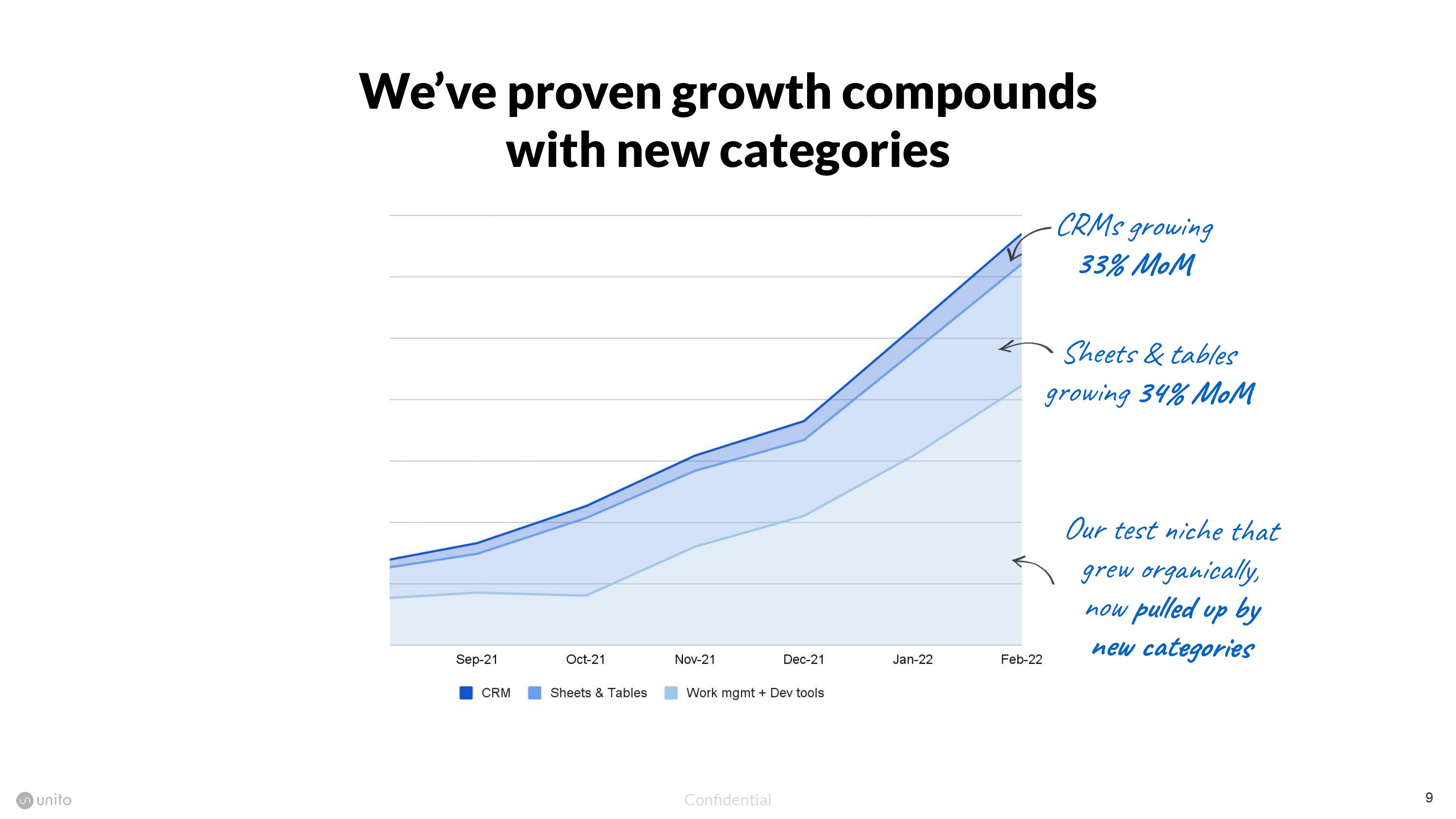
But it doesn’t show what the company is measuring here. Is this number of users? Number of syncs? Revenue?
And even then, this seems to fall short of my expectations; nowhere in this deck does it talk about the business model the company is currently using. The company’s pricing page offers a glimpse, but it feels like there’s a lot missing.
The business dashboard I crave here is, among other metrics, customer lifetime value (LTV) and customer acquisition cost (CAC). The absence of metrics makes this deck read like the company is a lot less mature than it is, and that doesn’t serve anyone.
The full pitch deck
If you want your own pitch deck teardown featured on TC+, here’s more information. Also, check out all our Pitch Deck Teardowns and other pitching advice, all collected in one handy place for you!































Comment